Your personal data is worth more than you think. Hence, protecting your online privacy goes far beyond using security tools like antivirus software, strong passwords, or a VPN. It’s better to take control of your personal data (yourself) that’s already out there.
Countless data brokers quietly collect and sell your information, from your home address to your browsing habits, often without your consent. Once your information is out there, bad actors, scammers, hackers, etc., can purchase your data en masse for mere pennies.
That’s where data removal services come in. These tools help you reclaim your privacy by tracking down and deleting your personal details from people-search sites, marketing databases, and shady corners of the web (the dark web).
This guide lists the top 5 data removal services to help you choose the most effective solution for keeping your digital footprint under control.
Best data removal services – Quick list
In a rush? Here, we’ve briefly reviewed the five of them that are top of our list.
- Incogni: (Best overall) It covers an extensive list of data brokers with automated removals and consistent checks, a hands-off approach to reducing your digital footprint.
- Aura: (Best for identity protection) A complete security suite that pairs data removal with credit monitoring, dark web monitoring, and parental controls.
- DeleteMe: (Best comprehensive coverage) Demonstrated removal from 150 – 750+ broker sites with quarterly follow-up to help remove the info.
- Optery: (Best free & DIY option) Has a stable free plan with exposure reports and upgrade options for automated removals.
- HelloPrivacy: (Best low-maintenance) Offers Straightforward design, advanced privacy protection with easy presentation of reports, dark web checking, and easy opt-outs.
Best data removal services – Detailed list
1. Incogni
In 2025, Incogni set the bar for data broker removal. Owned by Surfshark (the popular VPN service), Incogni has become one of the trusted and common privacy protection brands in the public domain. It has earned its position for scale, automation, and transparency.
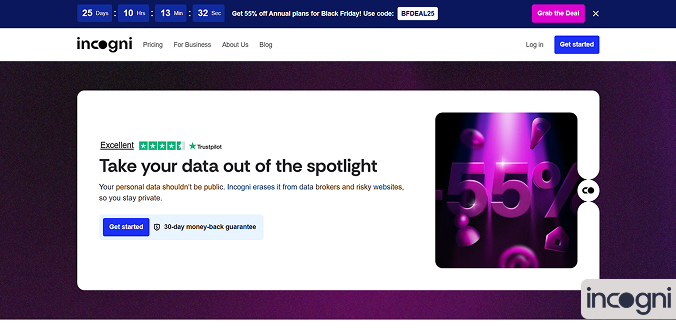
The service automatically contacts over 420 data brokers to send opt-out requests on your behalf. If you decide to move up to the Unlimited option, you can also add over 1,000 custom sites, such as database court records and company websites.
Once you sign up, Incogni will handle the hard work of attempting removal requests for you. Ongoing removals every 60–90 days help you to rest peacefully knowing that even if your data ever comes back, it won’t be there for long.
If you don’t want just data removal protection, you can bundle Incogni with Surfshark One+, which provides a VPN, antivirus, ad blocker, identity protection, and more. The service best price at $7.99–$31.98/month.
2. Aura
If you’re interested in more than just Data Broker removals, Aura is the most comprehensive identity protection suite on the market. It is designed not only to extract your information from broker sites but also to safeguard your family, devices, and finances.
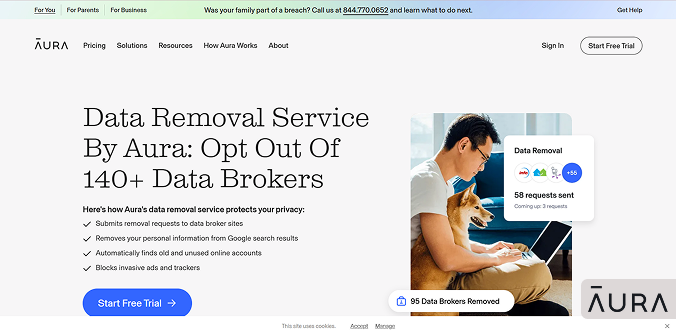
Aura combines your data broker removals experience with a total toolbox that includes identity theft insurance, fraud protection, dark web scanning (monitoring), antivirus, a VPN, password management, parental controls, and “White Glove” fraud remediation (in case your situation goes wrong).
When you sign up, Aura asks questions to understand your situation (family, financial habits), to provide the proper protection for you. We tested its spending alerts, which can be useful for a teen or young adult struggling with money management.
Aura shows your VantageScore, but not your full FICO score, which is what lenders will want. Price range $7.00–$20.00/month, it also offers a free trial for 14 days.
3. DeleteMe
If you just want something that is solely focused on getting your information deleted and will keep on it for you over time, then DeleteMe is a suitable option that has been around the privacy space for some time and has helped millions reduce their online footprint.
Depending on the plan you choose, it will request removals from 153–750+ data brokers. The service doesn’t just submit one opt-out and stop; it will continually request removals every three months to make sure your information does not come back.
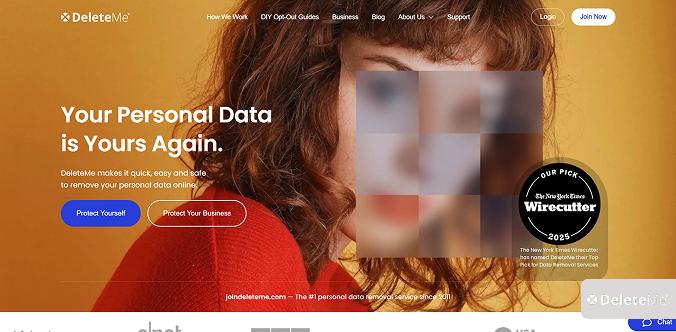
DeleteMe allows email, phone, and credit card masking. This means you can input “fake but valid” information into online forms, allowing you to sign up for services without actually using your real information. A clever way to reduce spam calls and spam emails.
With more than 100 million opt-out requests completed successfully, DeleteMe has one of the longest, most reliable histories in the data removal industry.
Phone masking is an additional $7 fee. At this price point, one would expect that feature would be included in the membership. The price $6.97–$34.40/month.
4. Optery
Optery is one of the best free options for removing data on the web, made for individuals who don’t mind doing a bit of the work themselves but prefer guidance and transparency.
It offers a free plan that has real value. Unlike competitors that offer only limited service, Optery finds your data on hundreds of data brokers and gives you a screenshot, so you can see for yourself where your personal info was found.
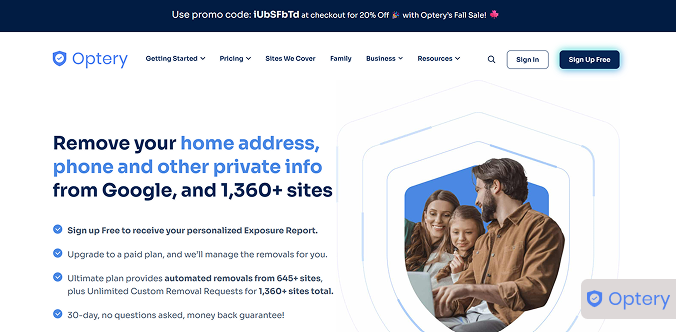
This alone provides a real assessment of how much your info is exposed. The free version of Optery allows you to get an Exposure Report every quarter. If you upgrade to the paid tier, you receive this report every month and automated scans and removals, with expedited opt-outs for additional managed support.
However, the free version has limited features and less reliable searches as compared to the paid tier.
5. HelloPrivacy
If you want a service that simply works in the background and doesn’t require much of your time, HelloPrivacy may be a good choice for you. It is designed for people who want privacy protection but lack the time to audit their settings.
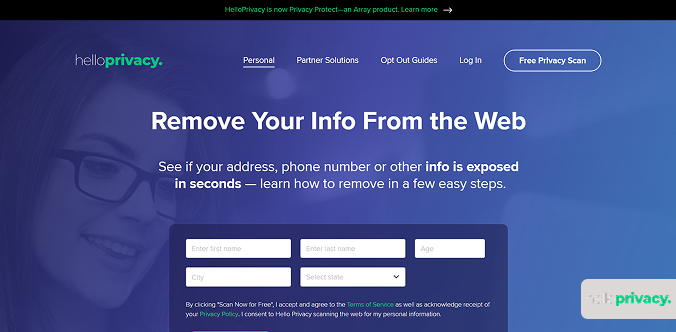
HelloPrivacy is easy to understand. No need to decode technical words, just receive statuses on progress. The website checks underground forums and markets for any leaked information; therefore, if your data is discovered in a high-risk location or on the dark web, you can remove it easily with HelloPrivacy. (If you want to know if your data is on the dark web or remove it from there, read our dedicated guide on that topic.)
In addition to removing brokers, HelloPrivacy aids you in filing complaints with the FCC and receiving unwanted marketing calls. For those of you who receive endless spam, these added features might save you. Subscription costs $7.99–$19.99 per month. You can also get a 7-day free trial.
What to look for in a data removal tool

Similar to many products and services, not all data removal services are created equal. Although they all have the same goal of removing your personal information from brokers, they could have different levels of comprehension among platforms, mobile applications, and websites.
If you’re shopping around, here are the most meaningful features and considerations:
- Recurring removals: Data brokers are non-stop collectors. A quality service will automatically resend opt-out requests at regular intervals, whether monthly or quarterly, to prevent your personal information from resurfacing.
- Transparency: Search for services that communicate exactly which data brokers they contacted and provide progress reports. The best tools allow for independent audits that back up their claims.
- Coverage: Some services cover slightly over one hundred brokers, and others provide removal requests for more than four hundred brokers. The most important sites to cover are the major people-search engines; our article on top people-search sites to be aware of uncovers them in detail.
- DIY support: If you want to manage the removals yourself, services such as Optery provide free exposure reports and templates to send opt-out requests.
- Fraud and dark web monitoring: Given that stolen data often ends up for sale on unmonitored, underground forums, having a service to monitor the dark web is an early warning system to protect yourself. This is especially crucial given the sheer scale of the dark web economy, where recent statistics show thousands of new stolen data listings appear daily.
- Money-back guarantees: Privacy tools vary in costs, which range from ridiculously expensive to reasonably priced, thus having a refund policy and or free trial period allows for property reviewing of a privacy tool.
By considering these factors, you can eventually pick a service that does more than just remove your information. One that also gives you peace of mind.
How exactly does data broker removal work?
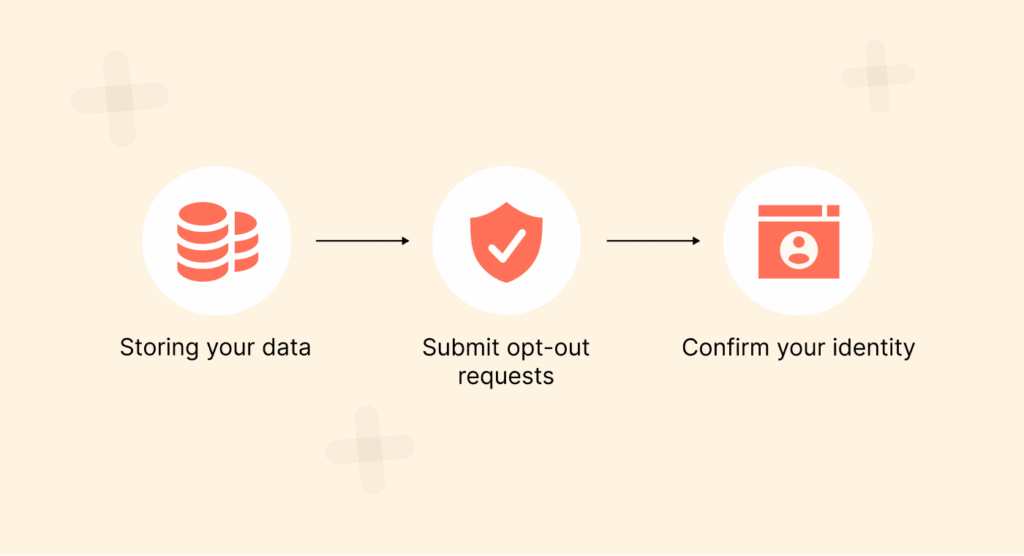
In a general sense, data removal has to do with the idea of exercising your right to opt out. Most brokers will be required to comply with your request to delete or suppress your data pursuant to a legal or regulatory obligation under privacy laws like CCPA in California or GDPR in Europe.
The problem with the approach, however, is that doing this on your own is often burdensome, confusing, and very tedious.
Here’s the process for removal:
- Locate brokers that are storing your data. Brokering services will search thousands of broker databases to locate any potential sites where your personally identifiable information may be found.
- Submit opt-out requests. You can choose to do this manually (you fill in forms and submit identification) or do this automatically (the service does it for you).
- Confirm your identity. Brokers typically request verification, such as an email verification or a picture of your ID, before destroying any records.
- Keep checking back. Brokers can resubmit their data, so the best services submit removal requests either monthly or quarterly.
You can certainly do this yourself, though it’s most likely excruciating and would take dozens of hours of work repeatedly.
Additionally, this process doesn’t remove your information from everywhere. Your information cannot be removed from court filings, government databases, or social media posts. Instead of thinking of them as a magic eraser, consider them to be a continual shield against an ongoing data breach in progress.
Who needs data removal services?

Not everyone spends their time worrying about data brokers; however, nearly everyone can become a victim of a data leak (somehow). Companies that collect and sell your personal information, such as your name, address, and shopping habits. For some, the risk is heightened – this is where data removal services could have substantive value.
Whether you are a journalist, lawyer, doctor, or anyone in a professional role, you likely face an elevated risk of harassment, negative attention, or doxxing (a type of online harassment). Keeping your home address and phone numbers off broker sites is a good start to protecting yourself.
During our testing, we found names, addresses, phone numbers, and even age data we’d submitted disappeared from the public broker databases we contacted to remove all identifiers after processing our opt-out requests. The downside is, removal is not a permanent action. Data brokers are tireless and continuously scrape new information from public records, loyalty programs, and online browsing.
That’s why ongoing removals (which most services offer either monthly to quarterly or bi-yearly) are so important. Incogni rechecks data broker sites monthly, except for DeleteMe, which rechecks every three months to ensure that your data stays down.
Additionally, this process doesn’t remove your information from everywhere. Your information cannot be removed from court filings, government databases, or social media posts. Instead of thinking of them as a magic eraser, consider them to be a continual shield against an
Are personal data removal services safe to use?
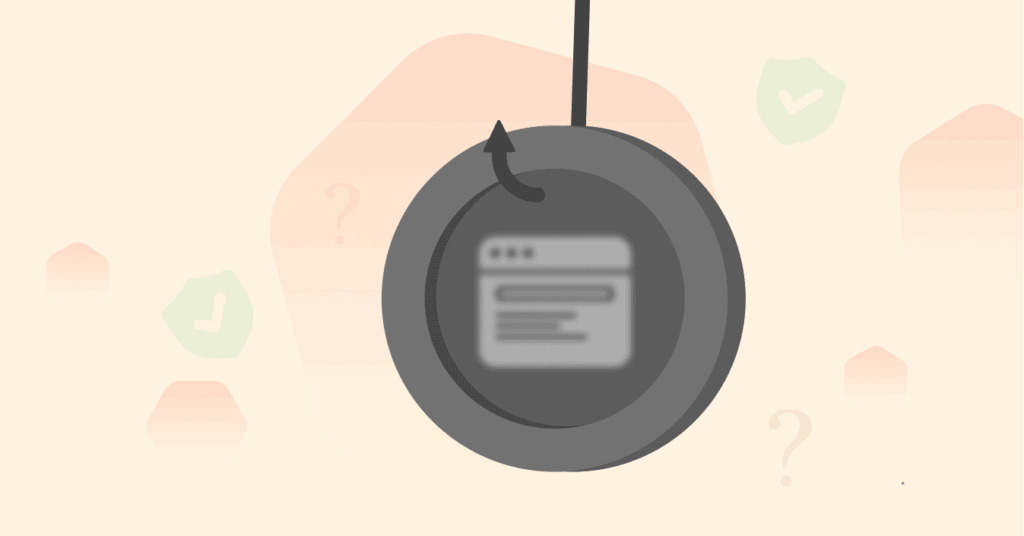
When it comes to sharing personal information with another company, it may seem counterintuitive for most people, as data removal services indicate that you do not want your information in the wrong hands.
Therefore, the question is whether the tools are, in fact, safe to use or not. Absolutely, if you discover and use reputable providers, you’ll worry about nothing.
Providers such as Incogni, DeleteMe, Aura, among others, have clear service policies regarding privacy, provide secure data protection, and even undergo third-party audits to confirm these claims.
For instance, Incogni’s audit from Deloitte in 2025 did confirm its coverage and the processes taken to remove data.
On the flip side, you would certainly be at risk of using a lesser-known or established service, as you could, in theory, enlist the help of a shady provider to take a different action with your data—guarding it or selling it into the wrong hands, in the exact opposite manner.
Therefore, always do the research before signing up for any service, even look for signs of legitimacy, including but not limited to company reputation, customer reviews, and assurance to comply with data protection regulations.
Limited data sharing provides an additional layer of safety. The best services will only collect the information necessary to verify your identity with their brokers and to keep you abreast of reports.
They should never ask for more than is appropriate, such as full financial account numbers. In summary, although no online service is without risk, it is safer to use a reliable data removal company than to leave your data hanging around on hundreds of broker sites.
How to remove personal information from the internet (do it yourself)

If you’re not ready to pay for a service, there are some do-it-yourself steps you can take to help lower your digital footprint, although it will involve some extra effort, and you can realistically make progress.
- Manually opt out of data brokers. Manually opt out of data brokers. Many brokers have opt-out forms buried on their sites. (For a detailed, step-by-step walkthrough, see our guide on how to remove your info from TruePeopleSearch, one of the most persistent people-search sites.)
- Remove or delete any old accounts. Use something like JustDelete.me to find the logins you forgot about and complete the shutdown. Inactive accounts can be easily hacked, and hackers can use them to simply steal your info after you have added it to a site.
- Tighten privacy on sites and in apps. Social sites are sharing more of your data than you realize. A crucial step is to disable ad tracking across your devices to prevent your activity from being collected and sold. Change your profile to private, limit viewing, or limit what gets shared. Disable sharing locations.
- Use a pseudonym or burner info. When signing up for services that you don’t really need, use information that’s not your phone number or email. If you have a masking tool to help, such as DeleteMe, Apple – “Hide My Email,” it can assist here.
- Watch for leaks. Put your email address through Have I Been Pwned to see if it has come up in a breach, and when necessary, update passwords.
Tracking and removing info yourself cannot truly compare to professional services as far as scale and automation, but it is a starting point and good to do that alongside, even if you end up paying for a service/tool at some point.
Incogni as compared to DeleteMe

Incogni and DeleteMe are the two most recognized names when it comes to data removal; however, they have different removal methods. So you have to really consider what’s more important to you when you’re selecting. Incogni is focused on automation and scale. With the support of Surfshark, Incogni automatically sends out opt-out requests to, and rechecks, 420+ data brokers monthly.
Incogni is able to demonstrate industry-leading coverage and transparency through its Deloitte audit and option to perform an unlimited number of one-off removals. With simple removals, Incogni is a good fit for you if you want a hands-off approach to privacy removal but a comfortable assurance that your information is regularly monitored.
In contrast, DeleteMe relies on persistence. It officially lists 153-750+ brokers, but they go on a quarterly cycle, so essentially every three months, it resubmits removal requests to keep your information down. There are also unique extras with DeleteMe, like email, phone, and credit card masking. These don’t relate to the removal of brokers but actively protect your identity for everyday use online.
So which one is the better choice for you? If the goal is the most streamlined and independently verified solution, then Incogni takes the lead. However, if you want more hands-on privacy tools and don’t mind the quarterly removals, then DeleteMe might be better.
FAQs
Data removal services are like digital cleaning services for your online identity—they find and remove your personal details, including addresses, phone numbers, and browsing history, from the thousands of data broker websites that sell personal information.
In 2025, the best data removal service is Incogni. Incogni automatically removes personal data from over 420 data broker sites, will continue to check the data brokers on a monthly basis, and undergo regular independent audits by Deloitte.
Yes, they are safe! Incogni, DeleteMe, and Aura are verified, credible providers that follow privacy regulations such as CCPA and only collect the data needed to perform removals. The data is encrypted, they are clear about how they operate, and they undergo third-party review services regularly.
The advantages are helpful to anyone who wants to cut back on spam, reduce the amount of phishing calls they receive, and have more control over their visibility online. The benefits are most helpful for professionals who have an audience. Families will benefit from protecting children’s information (Aura offers family plans, too).
It is possible to opt out of the brokers yourself, but it takes a lot of patience. You will need to visit each of the brokers’ sites, identify the brokers’ opt-out option, submit your request, and then return (frequently) to ensure that the broker has removed it. You can also use the privacy settings on your social media, delete old accounts, and you can use “Have I Been Pwned” to see if there have been leaks of your information.

